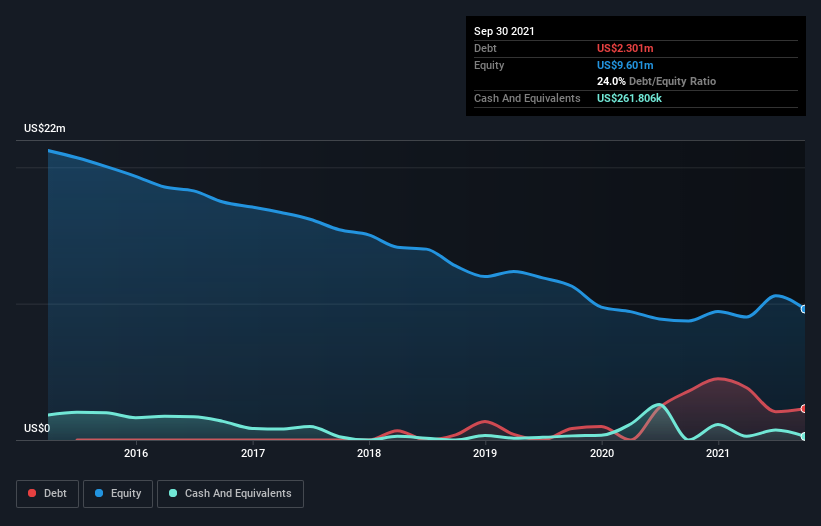- United States
- /
- Medical Equipment
- /
- OTCPK:AHPI.Q
Allied Healthcare Products (NASDAQ:AHPI) Is Carrying A Fair Bit Of Debt

Warren Buffett famously said, 'Volatility is far from synonymous with risk.' It's only natural to consider a company's balance sheet when you examine how risky it is, since debt is often involved when a business collapses. We can see that Allied Healthcare Products, Inc. (NASDAQ:AHPI) does use debt in its business. But is this debt a concern to shareholders?
When Is Debt A Problem?
Generally speaking, debt only becomes a real problem when a company can't easily pay it off, either by raising capital or with its own cash flow. If things get really bad, the lenders can take control of the business. However, a more common (but still painful) scenario is that it has to raise new equity capital at a low price, thus permanently diluting shareholders. By replacing dilution, though, debt can be an extremely good tool for businesses that need capital to invest in growth at high rates of return. The first step when considering a company's debt levels is to consider its cash and debt together.
See our latest analysis for Allied Healthcare Products
What Is Allied Healthcare Products's Net Debt?
The image below, which you can click on for greater detail, shows that Allied Healthcare Products had debt of US$2.30m at the end of September 2021, a reduction from US$3.58m over a year. On the flip side, it has US$261.8k in cash leading to net debt of about US$2.04m.

A Look At Allied Healthcare Products' Liabilities
The latest balance sheet data shows that Allied Healthcare Products had liabilities of US$7.44m due within a year, and liabilities of US$41.0k falling due after that. On the other hand, it had cash of US$261.8k and US$3.11m worth of receivables due within a year. So it has liabilities totalling US$4.10m more than its cash and near-term receivables, combined.
Allied Healthcare Products has a market capitalization of US$18.3m, so it could very likely raise cash to ameliorate its balance sheet, if the need arose. However, it is still worthwhile taking a close look at its ability to pay off debt. The balance sheet is clearly the area to focus on when you are analysing debt. But it is Allied Healthcare Products's earnings that will influence how the balance sheet holds up in the future. So when considering debt, it's definitely worth looking at the earnings trend. Click here for an interactive snapshot.
Over 12 months, Allied Healthcare Products saw its revenue hold pretty steady, and it did not report positive earnings before interest and tax. While that hardly impresses, its not too bad either.
Caveat Emptor
Importantly, Allied Healthcare Products had an earnings before interest and tax (EBIT) loss over the last year. Indeed, it lost US$1.3m at the EBIT level. Considering that alongside the liabilities mentioned above does not give us much confidence that company should be using so much debt. Quite frankly we think the balance sheet is far from match-fit, although it could be improved with time. However, it doesn't help that it burned through US$840k of cash over the last year. So suffice it to say we do consider the stock to be risky. The balance sheet is clearly the area to focus on when you are analysing debt. However, not all investment risk resides within the balance sheet - far from it. We've identified 4 warning signs with Allied Healthcare Products , and understanding them should be part of your investment process.
At the end of the day, it's often better to focus on companies that are free from net debt. You can access our special list of such companies (all with a track record of profit growth). It's free.
New: Manage All Your Stock Portfolios in One Place
We've created the ultimate portfolio companion for stock investors, and it's free.
• Connect an unlimited number of Portfolios and see your total in one currency
• Be alerted to new Warning Signs or Risks via email or mobile
• Track the Fair Value of your stocks
Have feedback on this article? Concerned about the content? Get in touch with us directly. Alternatively, email editorial-team (at) simplywallst.com.
This article by Simply Wall St is general in nature. We provide commentary based on historical data and analyst forecasts only using an unbiased methodology and our articles are not intended to be financial advice. It does not constitute a recommendation to buy or sell any stock, and does not take account of your objectives, or your financial situation. We aim to bring you long-term focused analysis driven by fundamental data. Note that our analysis may not factor in the latest price-sensitive company announcements or qualitative material. Simply Wall St has no position in any stocks mentioned.
About OTCPK:AHPI.Q
Allied Healthcare Products
Allied Healthcare Products, Inc. manufactures and markets respiratory products for use in the health care industry in a range of hospitals and alternate site settings worldwide.
Weak fundamentals or lack of information.
Market Insights
Community Narratives




